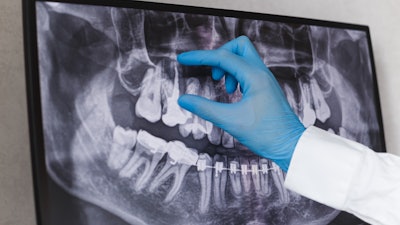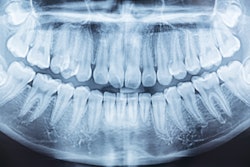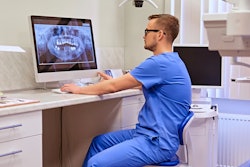
As dentists, we come to each patient encounter armed with our trusty x-rays, years of diagnostic experience and a commitment to helping each patient better understand and improve their oral health. But what if we could revolutionize that process, making it more efficient and engaging for our patients? Enter the transformative world of dental artificial intelligence (AI).
Some of the most pivotal moments in the patient experience occur when patients are in the exam chair. As dental professionals, we're used to seeing disease indications on x-rays and can quickly spot what may need a closer look. It's what we do every day. But for a patient, it can be tough to understand what's happening inside their mouth when we’re pointing at various shades of gray on digital film. My practice, Arch Dental of Manhattan, began using dental AI to explore its capabilities as a diagnostic aid and tool for patient communication, and we’ve been impressed so far.
 Dr. Jordan Reich.
Dr. Jordan Reich.
Without question, dental AI helps our team better communicate areas of concern and treatment recommendations to our patients. While it is helping enhance patient experiences, it also increases case acceptance rates, which in turn will improve oral health outcomes for the families and individuals we serve -- and that's what really matters.
Interested in leveraging dental AI to improve patient existence at your practice? Here's what you need to know based on our hands-on experience.
Step one: Picking your dental AI partner
The first step to using dental AI to help your patients is finding the right software. Several software platforms, each with unique features and benefits, are available these days. Be sure to look for a solution that allows you to import and analyze dental x-rays quickly and provides clear and easy-to-understand visualizations of areas of concern. For example, our team uses VideaAI by VideaHealth.
Using an AI platform helps our team identify potentially overlooked issues, since VideaAI data has been trained on 50 times more images than any dentist will see in their lifetime. We can focus on the patient and zero in on potential areas that require further investigation. Plus, we can spend more time on patient education and consultation, since we save time with automated analysis.
Step two: Show, tell, and train
The right dental AI software can make all the difference. Look for platforms offering swift import and analysis of dental x-rays and easy-to-comprehend visualizations of trouble spots. VideaAI by VideaHealth not only provides these, but it also integrates directly into existing workflows.
You’ll need to ensure your team is trained on how to use the software consistently to confidently explain findings to patients. VideaHealth’s team provided specific training for me and my role as a dentist and customized training for our hygienist team to help us understand how to maximize the potential of the software during patient interactions.
We’ve found that the objective calibration of AI helps us feel more confident in our diagnosis, and when we feel more confident, we can better communicate with our patients. And since dental AI annotates specific regions of interest, it's easy to standardize case presentations and provide customized explanations of findings tailored to each patient's case. This level of personalization enhances patient engagement and is vital in terms of helping them better understand the need for the specific treatment recommendations you and your team make.
Step three: Educate and alleviate worries
Patients who can easily comprehend the issues affecting their oral health feel more involved in their treatment decisions. The ability to visually depict areas of concern on x-rays more clearly cannot be understated. This helps patients see for themselves the issues that need to be addressed and, with your guidance, better understand treatment recommendations.
AI can also be instrumental in helping patients better understand the outcomes of their treatments. By creating before-and-after image results with a dental AI overlay, you can easily walk patients through positive changes that stem from following treatment recommendations -- and on the other side of the coin -- the adverse effects of delaying treatment. In either case, this can be particularly effective for patients who are hesitant about specific types of treatments or who have previously had negative dental care experiences.
You’re the doctor -- you always will be. AI is a powerful tool that can help you create a more effective and engaging patient experience. Integrating dental AI into your practice workflow and patient communication can profoundly impact patient trust, satisfaction, and, ultimately, case acceptance rates and outcomes.
Dr. Jordan Reich is a dental graduate of the University of Missouri, Kansas City in Kansas City, MO. He completed his general practice residency at Mercy Hospital in St. Louis. There, he trained in a variety of advanced skills, new procedures, and updates in the latest technology for dental care. Dr. Reich practices at Arch Dental of Manhattan in New York.
The comments and observations expressed herein do not necessarily reflect the opinions of DrBicuspid.com, nor should they be construed as an endorsement or admonishment of any particular idea, vendor, or organization.




















